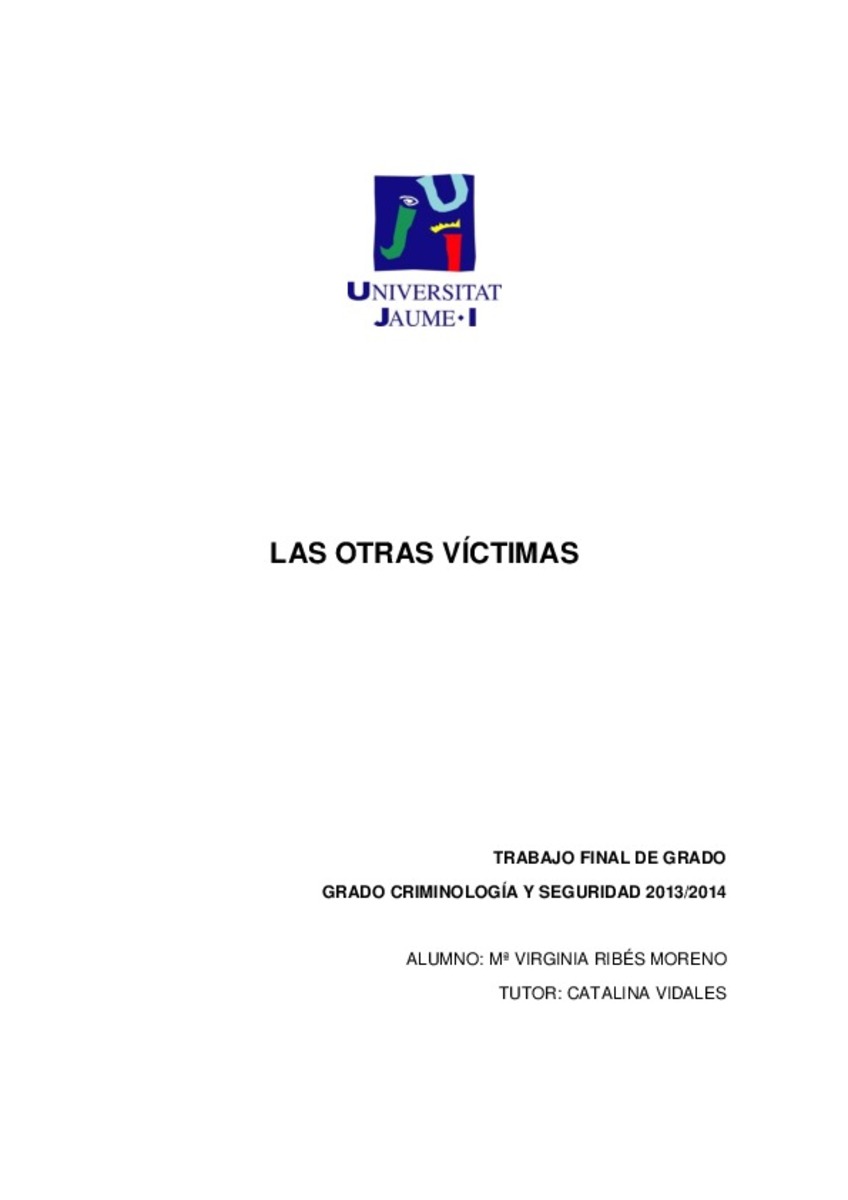Mostrar el registro sencillo del ítem
Las otras víctimas
| dc.contributor | Vidales Rodríguez, Caty | |
| dc.contributor | Universitat Jaume I. Departament de Dret Públic | |
| dc.contributor.author | Ribes Moreno, María Virginia | |
| dc.date.accessioned | 2014-11-11T09:48:04Z | |
| dc.date.available | 2014-11-11T09:48:04Z | |
| dc.date.issued | 2014-07-15 | |
| dc.identifier.uri | http://hdl.handle.net/10234/107859 | |
| dc.description | Final de Grau en Criminologia i Seguretat. Codi: CS1044. Curs academic: 2013-1014 | ca_CA |
| dc.description.abstract | Las víctimas han sido siempre las “gran olvidadas” en las ciencias penales y criminológicas. Solo a partir del nacimiento de la victimología se les ha otorgado la consideración que merecen, puesto que se deben configurar como elemento esencial de las conductas delictivas. De ahí la importancia de determinar quién debe ser considerada víctima, así como las categorías o niveles de victimización con los que nos podemos encontrar. El proceso de victimización tiene como protagonistas no solo a las víctimas directas de un hecho delictivo, sino también a otras personas que por su proximidad a dichas víctimas directas van a sufrir determinadas consecuencias derivadas del delito, fundamentalmente consecuencias de carácter psicológico, emocional y de reproche social. Estos aspectos deben ser analizados por la victimología en aras de establecer tanto medidas preventivas, como mecanismos de tratamiento para frenar o minimizar los efectos de la victimización. En último lugar, también es esencial plantear la necesidad de resocialización de las víctimas en un plano de igualdad respecto la resocialización de los delincuentes, a través de la búsqueda de programas que permitan la participación plena de las víctimas y la satisfacción de sus pretensiones, sin que ello suponga una merma en las garantías y derechos que tienen reconocidos los delincuentes. Victims have always been the “forgotten” part in the Criminal Law and Criminology. The only began to received the consideration they deserved after the Victimology´s birth, since they must be set as a key element in criminal behaviours. Due to this, it is very important to define who must be considered as a victim and set the victimization categories or levels we can face. The victimization process is not only starred by the direct victims of a crime. People close to the direct victims will also suffer consequences. Those consequences can be psychological, emotional or even rejection from society. Victimology should cover these aspects, in order to establish preventive measures and treatment mechanisms, therefore the effects of victimization could be decreased or even stopped. Finally, it is also important to set out the needs of the victim´s resocialization through systems or programs which allow the full participation of victims and the conformity to reach their targets. However, this must not mean to weaken the accepted guaranties and rights of the criminals. | |
| dc.format.extent | 50 p. | ca_CA |
| dc.format.mimetype | application/pdf | ca_CA |
| dc.language.iso | spa | ca_CA |
| dc.rights.uri | http://creativecommons.org/licenses/by-nc-nd/4.0/ | * |
| dc.subject | Grau en Criminologia i Seguretat | ca_CA |
| dc.subject | Grado en Criminología y Seguridad | ca_CA |
| dc.subject | Bachelor's Degree in Criminology and Security | ca_CA |
| dc.subject | Justicia | ca_CA |
| dc.subject | Víctima | ca_CA |
| dc.subject | Victimología | ca_CA |
| dc.subject | Victimización | ca_CA |
| dc.subject | Resocialización | ca_CA |
| dc.subject | Error judicial | ca_CA |
| dc.subject | Justice | ca_CA |
| dc.subject | Victim | ca_CA |
| dc.subject | Victimology | ca_CA |
| dc.subject | Victimization | ca_CA |
| dc.subject | Victim's resocialization | ca_CA |
| dc.subject | Miscarriage of justice | ca_CA |
| dc.title | Las otras víctimas | ca_CA |
| dc.type | info:eu-repo/semantics/bachelorThesis | ca_CA |
| dc.educationLevel | Estudios de Grado | ca_CA |
| dc.rights.accessRights | info:eu-repo/semantics/openAccess | ca_CA |
Ficheros en el ítem
Este ítem aparece en la(s) siguiente(s) colección(ones)
-
Grau en Criminologia i Seguretat [489]
CS1044








